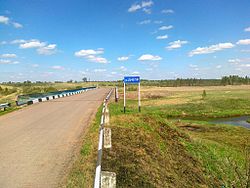Kholm-Zhirkovsky District
Холм-Жирковский район | |
|---|---|
 Bridge over Dnieper River, Nakhimovskoe, Kholm-Zhirkovsky District | |
 Location of Kholm-Zhirkovsky District in Smolensk Oblast | |
| Coordinates: 55°30′53″N 33°29′56″E / 55.51472°N 33.49889°E | |
| Country | Russia |
| Federal subject | Smolensk Oblast[1] |
| Established | 1 October 1929 |
| Administrative center | Kholm-Zhirkovsky[1] |
| Area | |
| • Total | 2,033.40 km2 (785.10 sq mi) |
| Population | |
| • Total | 10,717 |
| • Estimate (2018)[3] | 9,374 (−12.5%) |
| • Density | 5.3/km2 (14/sq mi) |
| • Urban | 32.6% |
| • Rural | 67.4% |
| Administrative structure | |
| • Administrative divisions | 1 Urban settlements, 14 Rural settlements |
| • Inhabited localities[1] | 1 Urban-type settlements[4], 177 rural localities |
| Municipal structure | |
| • Municipally incorporated as | Kholm-Zhirkovsky Municipal District[5] |
| • Municipal divisions[5] | 1 urban settlements, 14 rural settlements |
| Time zone | UTC+3 (MSK |
| OKTMO ID | 66654000 |
| Website | http://holm.admin-smolensk.ru/ |
Kholm-Zhirkovsky District (Russian: Холм-Жирковский райо́н) is an administrative[1] and municipal[5] district (raion), one of the twenty-five in Smolensk Oblast, Russia. It is located in the north of the oblast. The area of the district is 2,033.40 square kilometers (785.10 sq mi).[1] Its administrative center is the urban locality (a settlement) of Kholm-Zhirkovsky.[1] Population: 10,717 (2010 Census);[2] 12,815 (2002 Census);[7] 15,966 (1989 Census).[8] The population of the administrative center accounts for 32.6% of the district's total population.[2]

